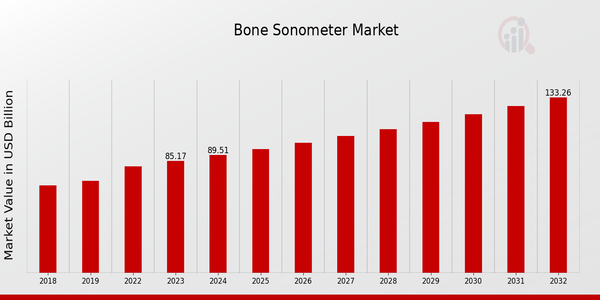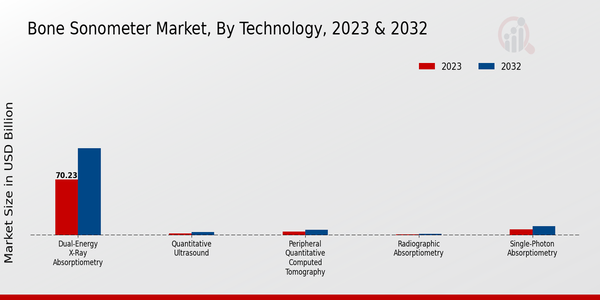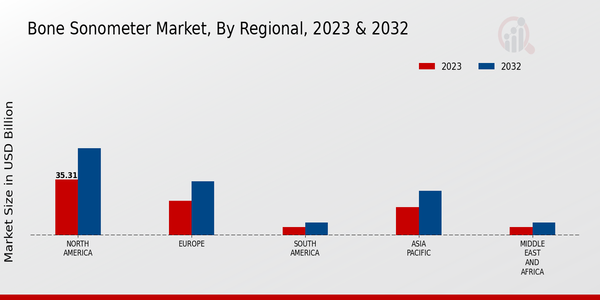Bone Sonometer Market Overview:
As per MRFR analysis, the bone sonometer market size was estimated at 1.14 (USD Billion) in 2023. The Bone Sonometer Market is expected to grow from 1.21 (USD Billion) in 2024 to 1.92 (USD Billion) by 2032. The bone sonometer market CAGR (growth rate) is expected to be around 5.23% during the forecast period (2024-2032).
Key Bone Sonometer Market Trends Highlighted
Advancements in technology, such as the incorporation of artificial intelligence (AI) and machine learning (ML) algorithms, have enhanced bone sonometer accuracy and diagnostic capabilities. These technologies enable more precise bone density measurements and improved detection of osteoporosis and other bone-related conditions, leading to more accurate diagnosis and efficient patient management.The increasing prevalence of osteoporosis and other bone diseases, coupled with an aging population, drives the demand for bone sonometers in the healthcare industry.
The rising awareness about bone health and the associated risk of fractures further contributes to market growth. Furthermore, the expansion of orthopedic and radiology clinics and the growing adoption of bone sonometers in these facilities create significant opportunities for market expansion. Additionally, the increasing focus on preventive healthcare and personalized medicine has spurred the demand for bone sonometers, as these devices aid in early detection and monitoring of bone health, empowering individuals to take proactive measures for bone health maintenance.

Source: Primary Research, Secondary Research, MRFR Database and Analyst Review
Bone Sonometer Market Drivers
Aging Population
The global population is aging, and this is leading to an increase in the number of people who are at risk of developing osteoporosis. Osteoporosis is a condition that causes bones to become weak and brittle, and it can lead to fractures.
Bone sonometers are used to diagnose osteoporosis and to monitor the effectiveness of treatment. As the population ages, the demand for bone sonometers is expected to increase. In addition to the aging population, there are several other factors that are driving the growth of the Bone Sonometer Market. These factors include:
- The increasing prevalence of obesity
- The rising awareness of osteoporosis
- The development of new and more accurate bone sonometer technologies
The Bone Sonometer Market is expected to grow significantly in the coming years. This growth will be driven by the increasing demand for bone sonometers from both developed and developing countries.
Rising Prevalence of Osteoporosis
Osteoporosis is a condition that affects the quality of bones, making them weak and brittle. It is a serious public health issue that must be addressed. It is estimated that over 200 million people suffer from osteoporosis worldwide. The number is likely to increase to over 300 million by 2050. The prevalence of the condition is likely to be increased by the rising incidence of aging population, increasing cases of obesity in society, and declines in the levels of physical activities.
Increased prevalence of osteoporosis is likely to lead to an increase in the demand for bone sonometer. It is used in the diagnosis of osteoporosis and in the monitoring of treatment. With the increasing prevalence of the condition, the demand for the equipment is also likely to rise.
Technological Advancements
The Bone Sonometer Market is driven by technological advancements. New and more accurate bone sonometer technologies are being developed, and these technologies are making it easier to diagnose and monitor osteoporosis.
For example, new bone sonometer technologies can measure bone density more accurately, and they can also measure bone density in different parts of the body. All of these are expected to promote the demand for bone sonometers.
Bone Sonometer Market Segment Insights:
Bone Sonometer Market Technology Insights
The technological landscape of the bone sonometer market is diverse, encompassing a range of modalities with varying strengths and applications. Dual-energy X-ray Absorptiometry (DXA) stands as the gold standard for bone mineral density (BMD) assessment, accounting for a significant share of the Bone Sonometer Market revenue.
Its high precision and accuracy make it the preferred choice for diagnosing and monitoring osteoporosis. Quantitative ultrasound (QUS), on the other hand, offers a portable and cost-effective alternative to DXA. It utilizes ultrasound waves to assess bone density, making it suitable for screening and monitoring in resource-constrained settings.
Peripheral quantitative computed tomography (pQCT) provides detailed three-dimensional images of bone structure, enabling the assessment of trabecular and cortical bone density. Radiographic absorptiometry (RA) and single-photon absorptiometry (SPA) are less commonly used techniques in the Bone Sonometer Market.
RA employs X-rays to measure bone density, while SPA utilizes a radioactive isotope to quantify bone mineral content. The choice of technology depends on factors such as accuracy, cost, portability, and patient population.
The Bone Sonometer Market is expected to witness significant growth in the coming years, driven by increasing awareness of osteoporosis and related bone disorders. The rising geriatric population, coupled with advancements in technology and expanding healthcare infrastructure, is anticipated to fuel market expansion. Key market players are investing in research and development to enhance the accuracy, precision, and accessibility of bone sonometer devices.

Source: Primary Research, Secondary Research, MRFR Database and Analyst Review
Bone Sonometer Market Application Insights
The application segment of the Bone Sonometer Market plays a critical role in driving market growth and shaping industry dynamics. Among the key applications, osteoporosis diagnosis and monitoring accounts for a significant portion of the market revenue. The rising prevalence of osteoporosis, particularly among the elderly population, has fueled the demand for accurate and reliable bone density measurements.
Fracture risk assessment is another important application, with bone sonometers used to evaluate bone strength and predict the likelihood of fractures, especially in individuals with low bone mineral density. Body composition analysis utilizes bone sonometers to determine body fat percentage, lean muscle mass, and other body composition metrics, catering to the growing demand for personalized health and fitness solutions.
Bone health research leverages bone sonometers to study bone structure, metabolism, and the impact of various factors on bone health, contributing to advancements in osteoporosis prevention and treatment. Growth and development monitoring employs bone sonometers to assess bone growth and development in children and adolescents, aiding in early detection of growth disorders and ensuring optimal skeletal development.
Bone Sonometer Market End User Insights
The Bone Sonometer Market is segmented by end user into hospitals and clinics, orthopedic and bone health centers, research institutions, fitness and wellness centers, and home healthcare settings. Hospitals and clinics are the largest end user segment for the Bone Sonometer Market, accounting for over 50% of the market share in 2023. This segment is expected to continue to dominate the market throughout the forecast period, driven by the increasing prevalence of osteoporosis and other bone-related disorders, as well as the growing adoption of advanced bone sonometer technologies in hospitals and clinics.
Orthopedic and bone health centers are the second largest end user segment and are expected to grow at a CAGR of over 6% during the forecast period. This growth is attributed to the increasing number of orthopedic procedures being performed, as well as the rising demand for specialized bone sonometer services in these centers.
Research Institutions are another important end user segment, accounting for a significant share of the Bone Sonometer Market revenue. These institutions are involved in research and development of new bone sonometer technologies, as well as the evaluation of new applications for existing technologies. Fitness and wellness centers and home healthcare settings are also expected to contribute to the growth of the Bone Sonometer Market over the forecast period.
Bone Sonometer Market Portability Insights
The bone sonometer market is segmented by portability into portable and stationary. Portable bone sonometers are designed for easy transportation and can be used in various settings, including clinics, hospitals, and even at home. They are lightweight and compact, making them convenient for healthcare professionals to use during patient visits or screenings. Portable bone sonometers offer flexibility and accessibility, enabling healthcare providers to reach a wider patient population.
Stationary bone sonometers, on the other hand, are larger and more sophisticated devices typically found in hospitals or specialized clinics. They provide high-precision measurements and are often used for research purposes or for patients with complex conditions. Stationary bone sonometers offer advanced features and functionalities that may not be available in portable devices. In 2023, the Portable Bone Sonometer segment held a significant share of the Bone Sonometer Market revenue due to its versatility and ease of use.
The growing demand for home healthcare and remote patient monitoring is expected to drive the growth of the portable segment in the coming years. Portable bone sonometers offer convenience and accessibility, enabling patients to monitor their bone health from the comfort of their own homes.
The Bone Sonometer Market is expected to register a steady market growth over the forecast period, driven by increasing awareness about bone health, technological advancements, and the rising prevalence of osteoporosis and other bone-related conditions.
Bone Sonometer Market Anatomy Scanned Insights
The Bone Sonometer Market is segmented by anatomy scanned into whole body, peripheral (e.g., heel, forearm), and specific regions (e.g., lumbar spine, hip). Among these segments, the whole body segment is expected to hold the largest market share in 2024 and is projected to continue its dominance throughout the forecast period.
The growth of this segment can be attributed to the increasing demand for whole-body bone density scans for the diagnosis and monitoring of osteoporosis, a condition that weakens bones and makes them more susceptible to fractures.
The peripheral segment is also expected to witness significant growth during the forecast period, owing to the rising prevalence of osteoporosis and other bone-related conditions in the geriatric population. Additionally, the increasing adoption of peripheral bone sonometers in point-of-care settings is expected to drive the growth of this segment.
Bone Sonometer Market Regional Insights
The Bone Sonometer Market segmentation by region is expected to be dominated by North America from 2023 to 2032, followed by Europe. The North American regional market is expected to have a market value of USD 32.52 billion by 2024, and is projected to reach USD 51.97 billion by 2032, growing at a CAGR of 5.6%.
The European regional market is expected to have a market value of USD 20.15 billion by 2024, and is projected to reach USD 32.26 billion by 2032, growing at a CAGR of 5.2%. The APAC regional market is expected to have a market value of USD 16.49 billion by 2024, and is projected to reach USD 26.41 billion by 2032, growing at a CAGR of 5.3%.
The South American market is expected to have a market value of USD 4.66 billion by 2024, and is projected to reach USD 7.46 billion by 2032, growing at a CAGR of 5.4%. The MEA regional market is expected to have a market value of USD 3.77 billion by 2024, and is projected to reach USD 6.06 billion by 2032, growing at a CAGR of 5.5%.

Source: Primary Research, Secondary Research, MRFR Database and Analyst Review
Bone Sonometer Market Key Players and Competitive Insights:
Major players in the market are focusing on strategic collaborations, product launches, and geographical expansion to gain a competitive edge. The competitive landscape of the bone sonometer market is characterized by the presence of a few leading players who hold a significant market share. These players are continuously investing in research and development to enhance their product offerings and stay ahead of the competition. Innovation and technological advancements are key factors driving the growth of the bone sonometer market.
Leading bone sonometer market players are actively involved in developing advanced Bone Sonometer Market solutions, such as dual-energy X-ray absorptiometry (DXA) and ultrasound-based bone sonometers, to meet the evolving needs of healthcare professionals and patients. The development of portable and handheld bone sonometers is also gaining traction, as they offer greater convenience and accessibility for bone density screening.
Hologic, Inc. is a leading player with a strong global presence. The company offers a comprehensive portfolio of bone sonometer products, including DXA systems and ultrasound-based bone sonometers. Hologic's DXA systems are widely used in clinical settings for bone mineral density testing and osteoporosis diagnosis. The company also offers advanced software solutions for bone sonometer data analysis and reporting. Hologic's commitment to innovation and customer satisfaction has contributed to its leading position in the bone sonometer market.
GE Healthcare is another major player in the bone sonometer market competitive landscape. The company provides a range of bone sonometer products, including DXA scanners and quantitative computed tomography (QCT) systems. GE Healthcare's DXA scanners are known for their high precision and accuracy, making them a preferred choice for bone density measurements. The company also offers advanced software solutions for bone sonometer data analysis and reporting. GE Healthcare's global distribution network and strong brand recognition contribute to its success in the bone sonometer market.
Key Companies in the Bone Sonometer Market Include:
- Digirad
- Mindray Medical
- Zimmer Biomet
- Samsung Electronics
- Carestream Health
- Planmed
- Osteometer
- Stryker
- Hitachi Medical
- Esaote
- FUJIFILM Holdings
- GE Healthcare
- Hologic
- Siemens Healthineers
- Medtronic
Bone Sonometer Market Developments
The Bone Sonometer Market is anticipated to reach a valuation of 1.92 billion USD by 2032, exhibiting a 5.23% CAGR from 2024 to 2032. This growth is attributed to the rising prevalence of osteoporosis, increasing awareness of bone health, technological advancements, and favorable reimbursement policies.
Key players in the market include Hologic, GE Healthcare, Medtronic, and Esaote. Recent developments include the launch of advanced bone sonometers with improved precision and portability, as well as the growing adoption of AI and machine learning for osteoporosis diagnosis and management. The market is expected to benefit from increasing healthcare expenditure, government initiatives, and strategic partnerships among industry stakeholders.
Bone Sonometer Market Segmentation Insights
Bone Sonometer Market Technology Outlook
- Dual-energy X-ray Absorptiometry (DXA)
- Quantitative Ultrasound (QUS)
- Peripheral Quantitative Computed Tomography (pQCT)
- Radiographic Absorptiometry (RA)
- Single-Photon Absorptiometry (SPA)
Bone Sonometer Market Application Outlook
- Osteoporosis Diagnosis and Monitoring
- Fracture Risk Assessment
- Body Composition Analysis
- Bone Health Research
- Growth and Development Monitoring
Bone Sonometer Market End User Outlook
- Hospitals and Clinics
- Orthopedic and Bone Health Centers
- Research Institutions
- Fitness and Wellness Centers
- Home Healthcare Settings
Bone Sonometer Market Portability Outlook
Bone Sonometer Market Anatomy Scanned Outlook
- Whole Body
- Peripheral (e.g., heel, forearm)
- Specific Regions (e.g., lumbar spine, hip)
Bone Sonometer Market Regional Outlook
- North America
- Europe
- South America
- Asia Pacific
- Middle East and Africa
| Report Attribute/Metric |
Details |
| Market Size 2023 |
1.14(USD Billion) |
| Market Size 2024 |
1.21(USD Billion) |
| Market Size 2032 |
1.92(USD Billion) |
| Compound Annual Growth Rate (CAGR) |
5.23% (2024-2032) |
| Report Coverage |
Revenue Forecast, Competitive Landscape, Growth Factors, and Trends |
| Base Year |
2023 |
| Market Forecast Period |
2024-2032 |
| Historical Data |
2019-2023 |
| Market Forecast Units |
USD Billion |
| Key Companies Profiled |
Digirad, Mindray Medical, Zimmer Biomet, Samsung Electronics, Carestream Health, Planmed, Osteometer, Stryker, Hitachi Medical, Esaote, FUJIFILM Holdings, GE Healthcare, Hologic, Siemens Healthineers, Medtronic |
| Segments Covered |
Technology, Application, End User, Portability, Anatomy Scanned, Region |
| Key Market Opportunities |
1. Expanding Aging Population 2. Growing Prevalence of Osteoporosis 3. Technological Advancements 4. Rising Geriatric Population 5. Increasing Demand for Early Diagnosis of Bone Diseases |
| Key Market Dynamics |
1. Increasing Prevalence of Osteoporosis 2. Technological Advancements in Bone Sonometry 3. Rising Demand for Preventive Healthcare 4. Government Initiatives and Funding 5. Enhanced Focus on Bone Health |
| Countries Covered |
North America, Europe, APAC, South America, MEA |
Frequently Asked Questions (FAQ) :
The Bone Sonometer Market is expected to reach USD 1.92 billion by 2032, growing at a CAGR of 5.23% from 2024 to 2032.
North America is expected to hold the largest market share in the Bone Sonometer Market throughout the forecast period.
The osteoporosis diagnosis segment is expected to account for the highest market share in the Bone Sonometer Market throughout the forecast period.
Some of the key competitors in the Bone Sonometer Market include GE Healthcare, Hologic, Inc., Medtronic plc, Siemens Healthineers AG, and SonoSite, Inc.
The increasing prevalence of osteoporosis, the growing geriatric population, and the rising awareness of bone health are some of the key trends driving the growth of the Bone Sonometer Market.
The high cost of bone sonometer devices and the lack of skilled professionals are some of the challenges faced by the Bone Sonometer Market.
The growing demand for early diagnosis of osteoporosis and the development of new and innovative technologies are some of the opportunities for the Bone Sonometer Market.
The forecast period for the Bone Sonometer Market is from 2023 to 2032.
The CAGR of the Bone Sonometer Market is expected to be 5.23% from 2023 to 2032.
The base year for the Bone Sonometer Market is 2023.

















